Sharp GR8 is a television created primarily for those who expect an exceptionally smooth image. It is essentially the successor to the FQ8 model, and it's clear that the manufacturer has heavily focused on the aspect of motion dynamics. 144 Hz makes a difference – and not just in games. Sports broadcasts can also look fantastic, without those annoying blurring or "choppiness" that can take the joy out of watching. In terms of image quality, Sharp opted for a VA panel. While it doesn't feature local dimming, you can still count on pleasant contrast. Additionally, there's Dolby Vision, which gives evening movie screenings depth – even if the TV doesn't reach the brightness claimed by the manufacturer. It must be said that when the lights in the room are dimmed, the overall look is really pleasing to the eye. One of the biggest advantages of the GR8 is Google TV. We have access to a full range of applications, voice search in Polish, and a simple, intuitive interface. This means we don't have to limit ourselves to the standard TV functions, as there is always the option to install additional programs and tailor the system to our own needs. Of course, a few things could have been polished. The declared HDR brightness is higher on paper than in reality, which may leave the most discerning cinema enthusiasts feeling unsatisfied. Moreover, a few useful features known from other models are missing: there’s no USB recording or PiP functionality, and Apple device owners will be disappointed by the lack of AirPlay. Nevertheless, this is a television mainly aimed at those who value smooth visuals and high refresh rates. If we primarily care about dynamic gameplay and good support for games, while wanting to quietly enjoy a film in the evenings with pleasing quality, the Sharp GR8 should meet those expectations.
- Matching (Score)
- Our verdict
- TV appearance
- Where to buy
- Contrast and black detail
- HDR effect quality
- Factory color reproduction
- Color reproduction after calibration
- Smoothness of tonal transitions
- Image scaling and smoothness of tonal transitions
- Blur and motion smoothness
- Console compatibility and gaming features
- Input lag
- Compatibility with PC
- Viewing angles
- TV efficiency during daytime
- Details about the matrix
- TV features
- Apps
- Playing files from USB
- Sound
Sharp GR8 vs Philips PUS8500
Direct compare
GR8765E / GR8465E / GR8265E
PUS8500 / PUS8560 / PUS8510 / PUS8600

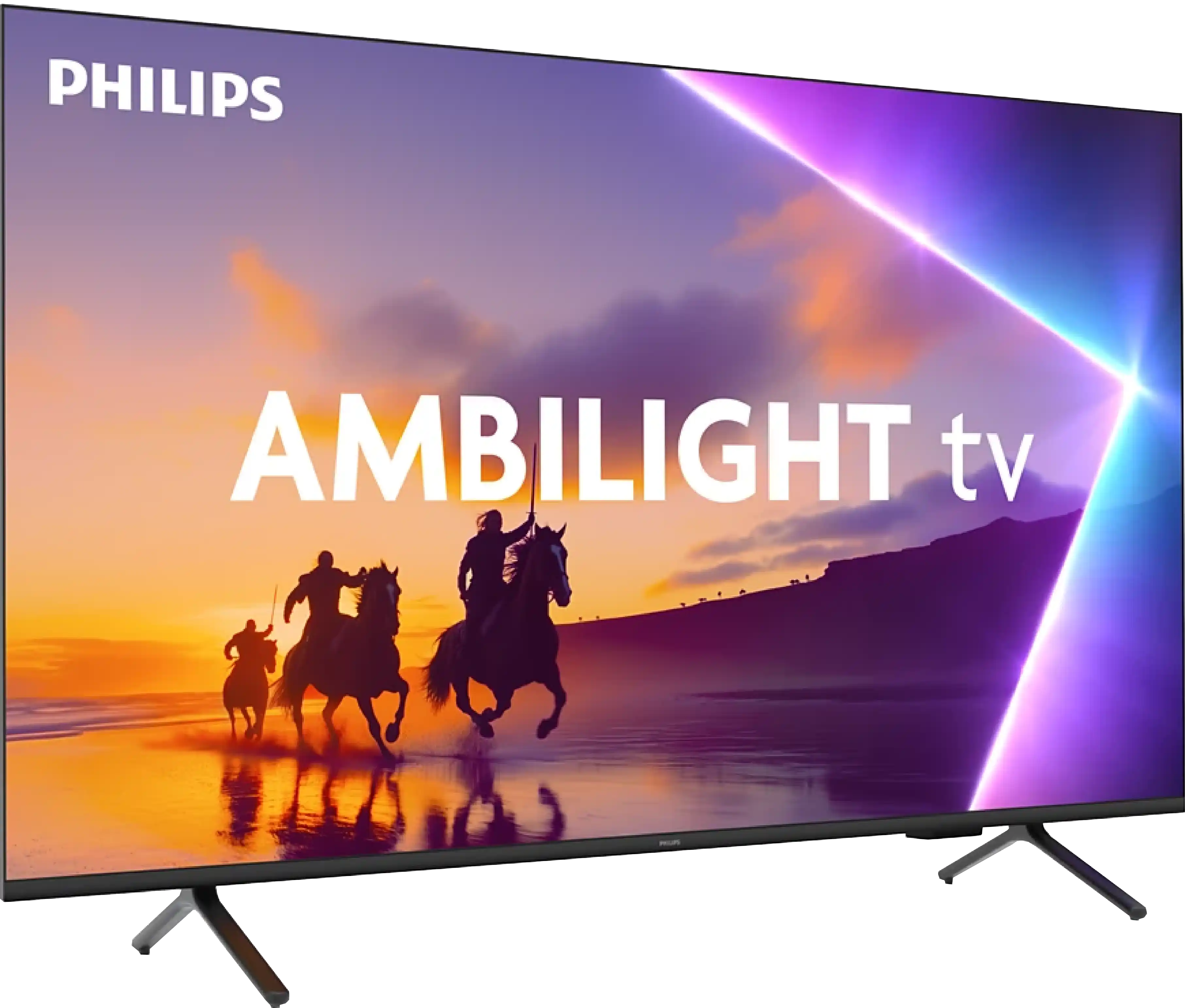
Panel type: LCD VA
Resolution: 3840x2160
System: Google TV
Model year: 2024
Complete the survey to find out the result

Panel type: LCD VA
Resolution: 3840x2160
System: Titan OS
Model year: 2025
Complete the survey to find out the result

Overall rating
6.4
5.6
Movies and series in UHD quality
6.2
5.4
Classic TV, YouTube
6.1
6.1
Sports broadcasts (TV and apps)
6.4
5.2
Gaming on console
7.8
6.7
TV as a computer monitor
4.0
5.6
Watching in bright light
4.5
4.9
Utility functions
6.5
4.9
Apps
9.6
4.6
Sound quality
7.0
6.2
Complete the survey to find out what fits your preferences
Advantages
VA matrix with decent contrast
144 Hz refresh rate and two HDMI 2.1 ports – a great option for gamers
Support for VRR and ALLM, low input lag
Dolby Vision support
Google TV with a rich selection of apps, voice search in Polish, and an intuitive interface
Decent sound
Ambilight System
High native contrast - VA panel
Low input lag
Essential features for gamers: ALLM and VRR
Full support for audio formats: Dolby Atmos and DTS
Backlit remote with numerical keypad
Disadvantages
HDR brightness is lower than claimed by the manufacturer (around 360 nits instead of 500)
In PC mode, it does not support 4:4:4 chroma – text and fonts are therefore less readable
No USB recording and PiP function
No support for AirPlay – Apple device owners may feel disappointed
Average panel brightness
The TitanOS system feels unfinished (some features don't work, gaps in applications)
Infrared remote control
Font readability issues (PC)
Our verdict
Ambilight because that's exactly where we need to start, it's the biggest reason to buy the PUS8500. The three-sided backlighting on the TV looks fantastic, especially in the evening. It creates atmosphere, masks contrast imperfections, and makes viewing simply more enjoyable. Even if the black isn’t perfect here, at high contrast the native VA panel is just good. On top of that, there’s really decent input lag and several gaming features like ALLM and VRR. Although there’s no HDMI 2.1 or 120Hz panel, casual gaming should be a pleasure. Especially since it plays responsively and without delays. Let’s add full support for audio formats – it includes both Dolby Atmos and DTS, so soundbar owners also have something to be happy about.
But let’s not kid ourselves – this is still a budget TV, and at times that’s quite obvious. Brightness is average – not so weak that you can't watch anything, but if you hit an exceptionally sunny day, watching under such conditions without blinds can be problematic. However, in our opinion, the biggest disappointment with the PUS8560 is the Titan OS operating system. Despite the fact that the system debuted some time ago, some things just didn’t work – for example, screen mirroring from a phone despite the manufacturer stating that this feature is present. There are fewer apps than the competition, and the system itself feels a bit clunky. Generally, it seems to do something already, but it clearly lacks refinement.
Of course, this isn’t a TV meant to compete with top models. But if someone is looking for something simple, with the cool atmosphere that the Ambilight system provides, it’s quite a fair proposition. You just need to know what to expect and accept the compromises, of which there are plenty here.
TV appearance




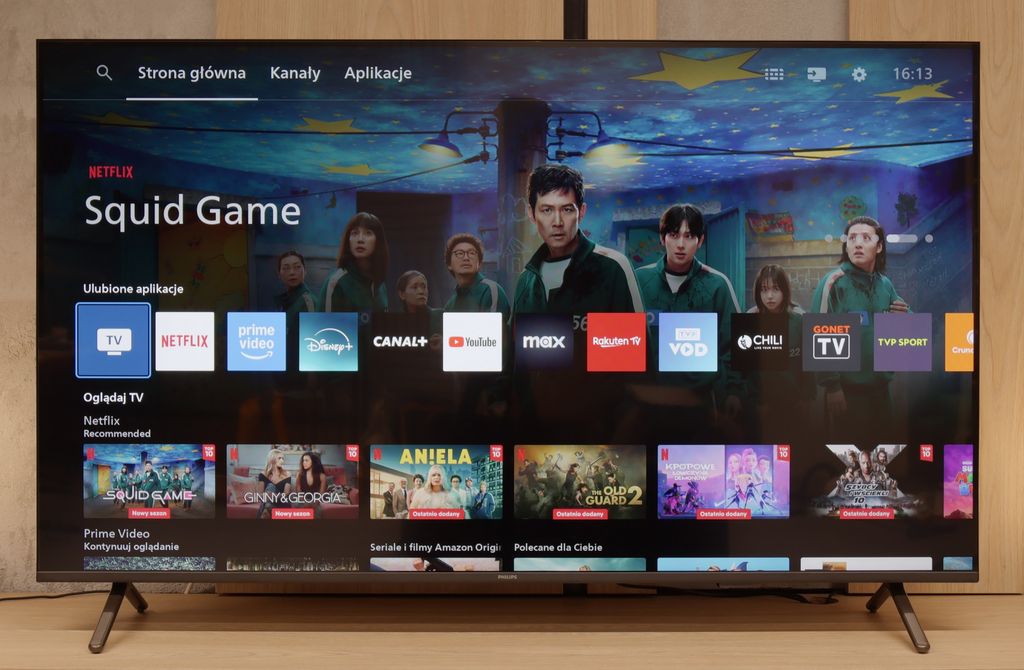
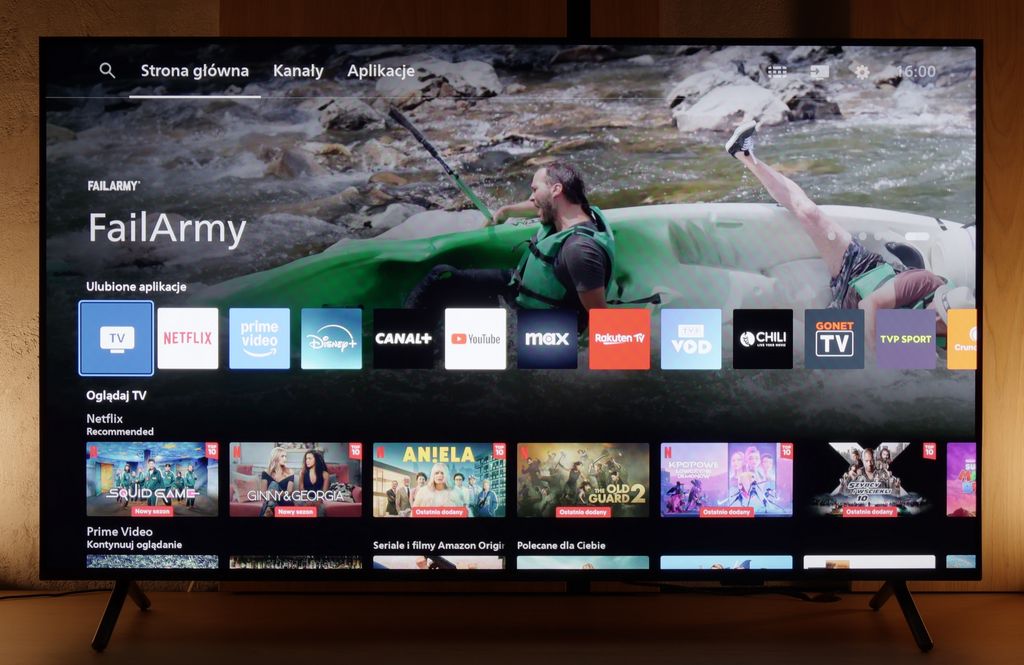
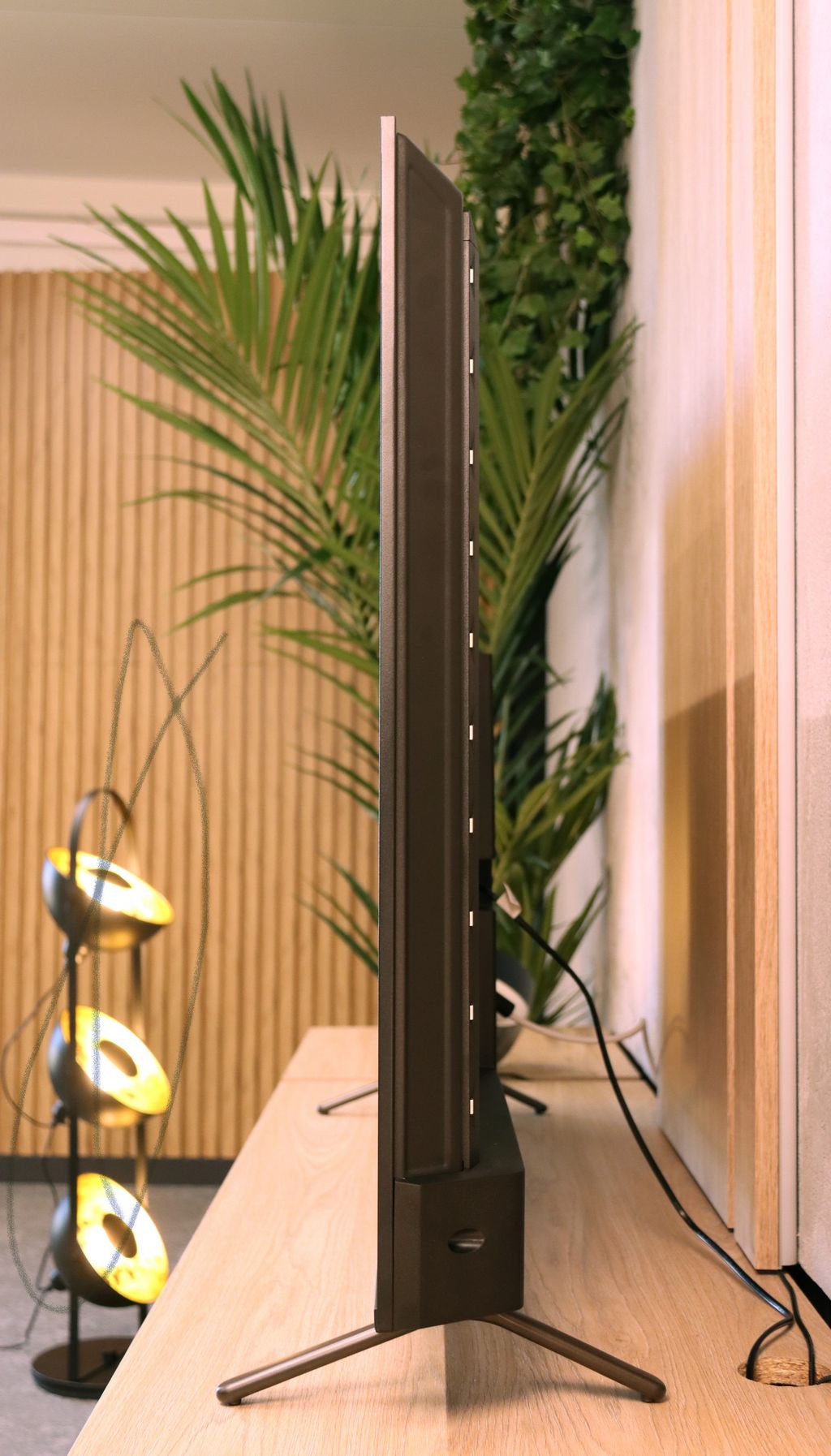
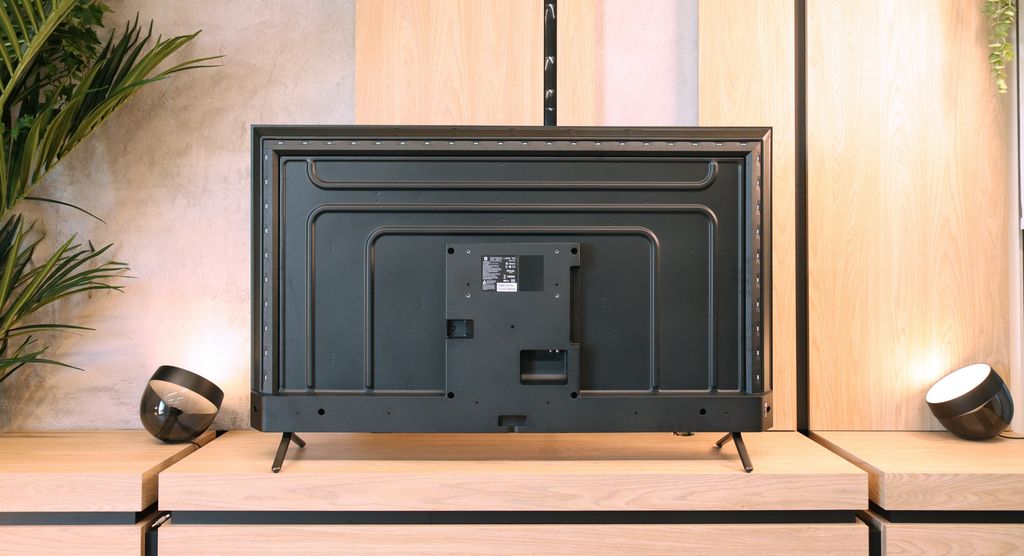
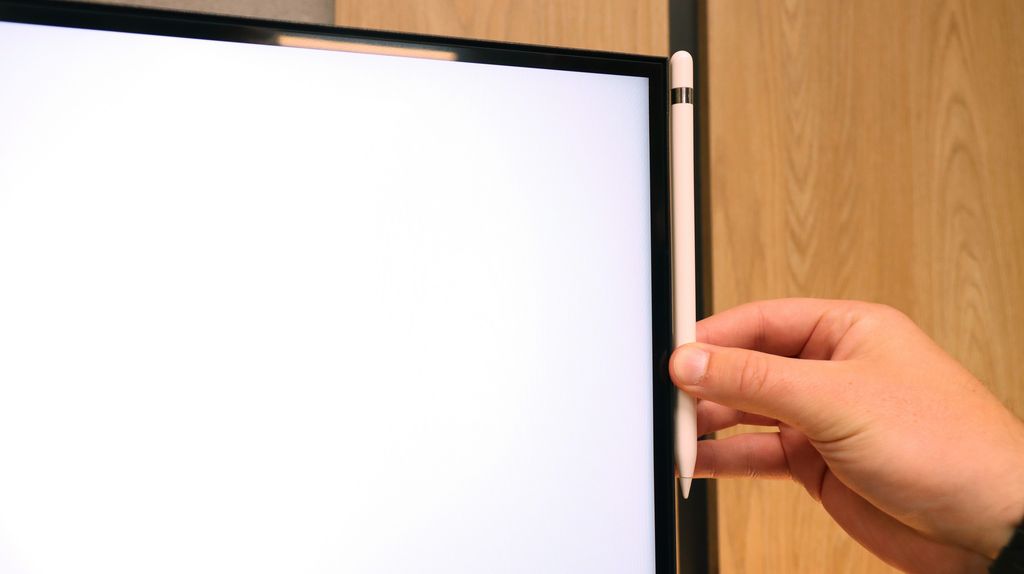
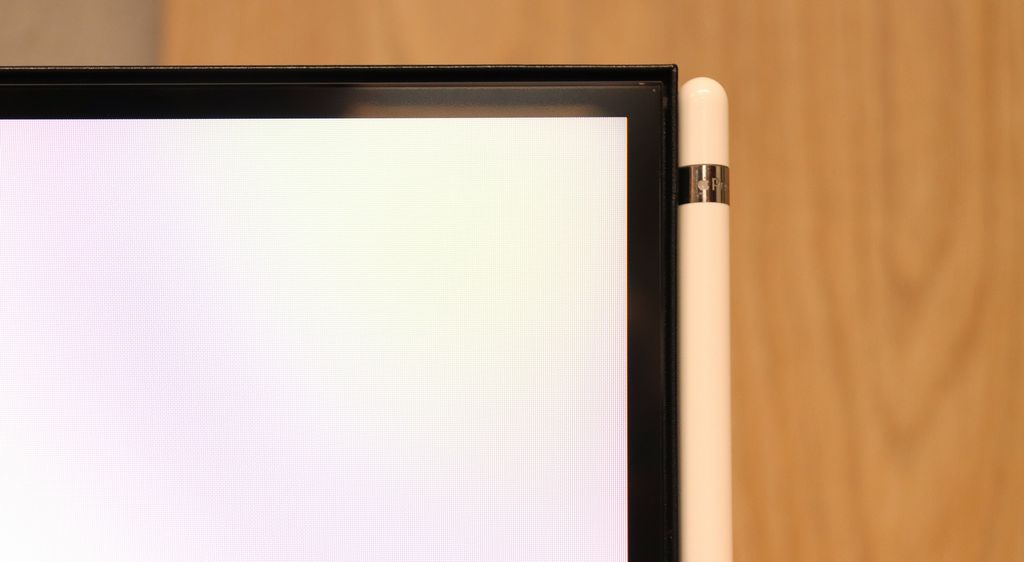

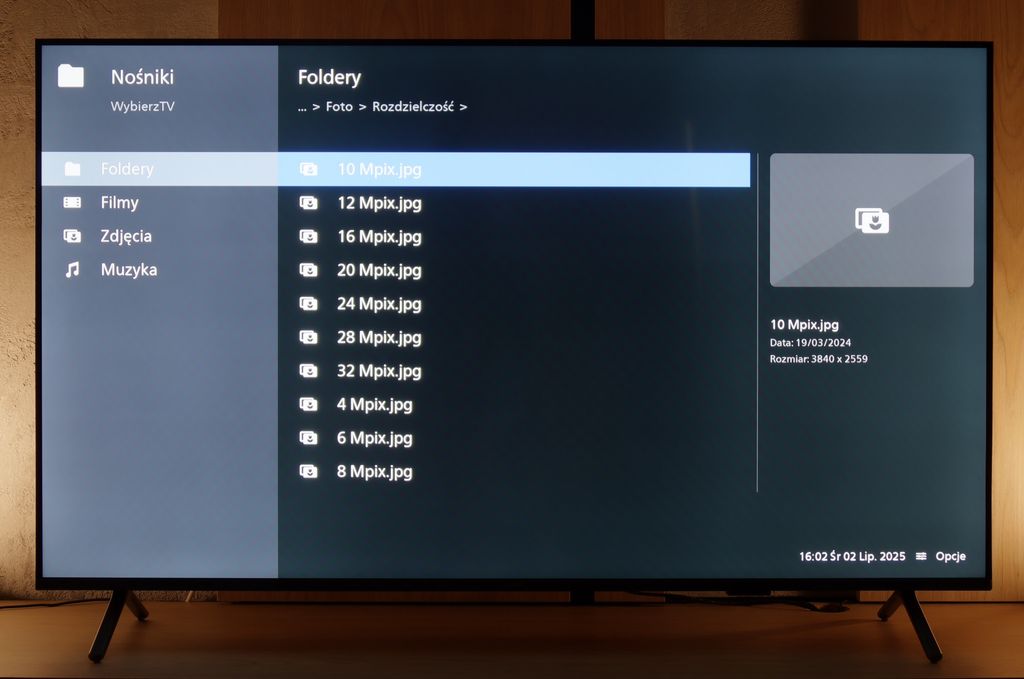
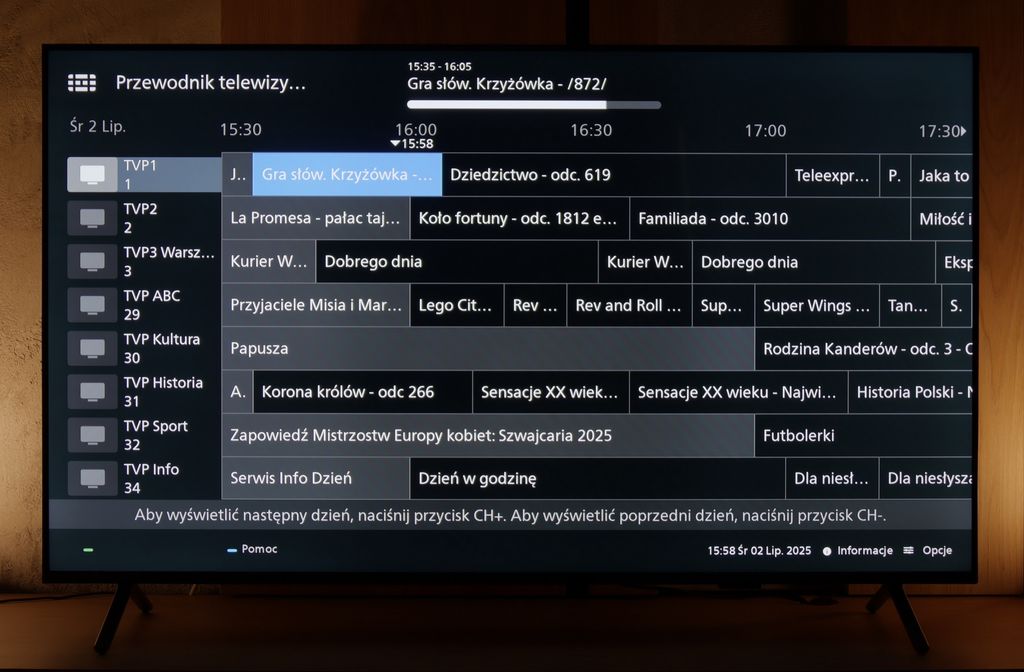
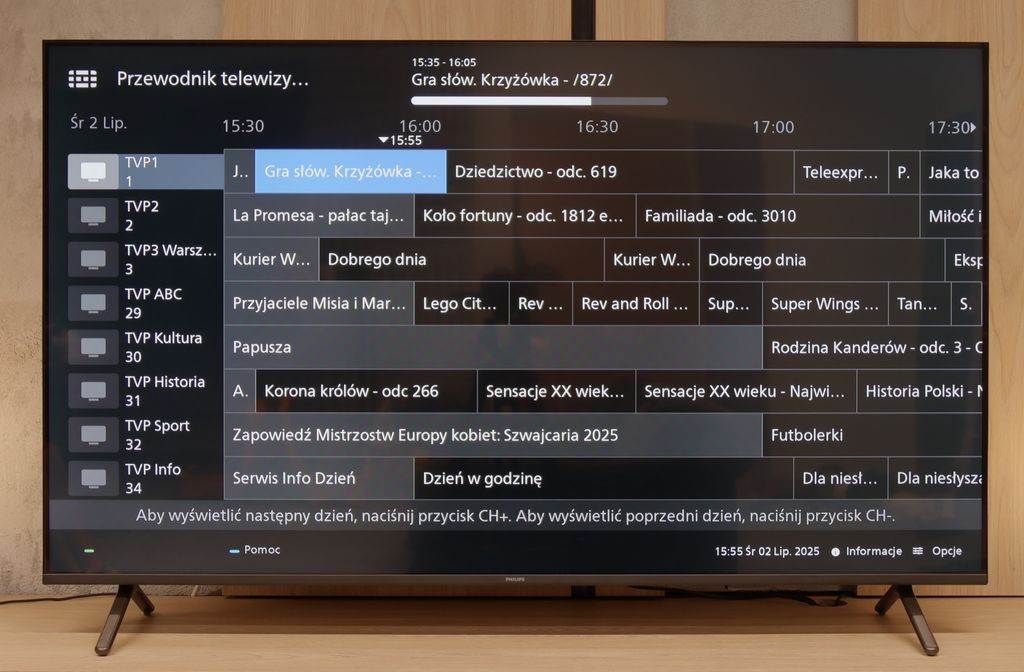
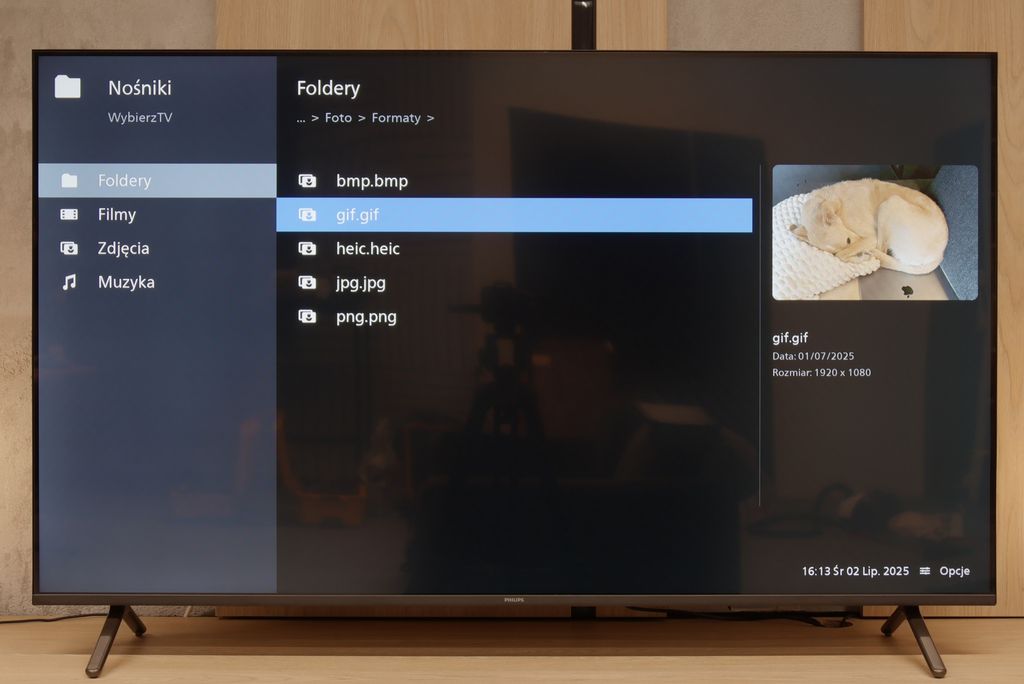
Contrast and black detail
5.9/10
6.1/10
Local dimming function: No
Local dimming function: No
Contrast:

Result
5,300:1

Result
5,800:1

Result
6,600:1

Result
5,650:1

Result
4,700:1

Result
6,000:1

Result
5,950:1

Result
6,250:1

Result
5,950:1

Result
5,750:1
Halo effect and black detail visibility:

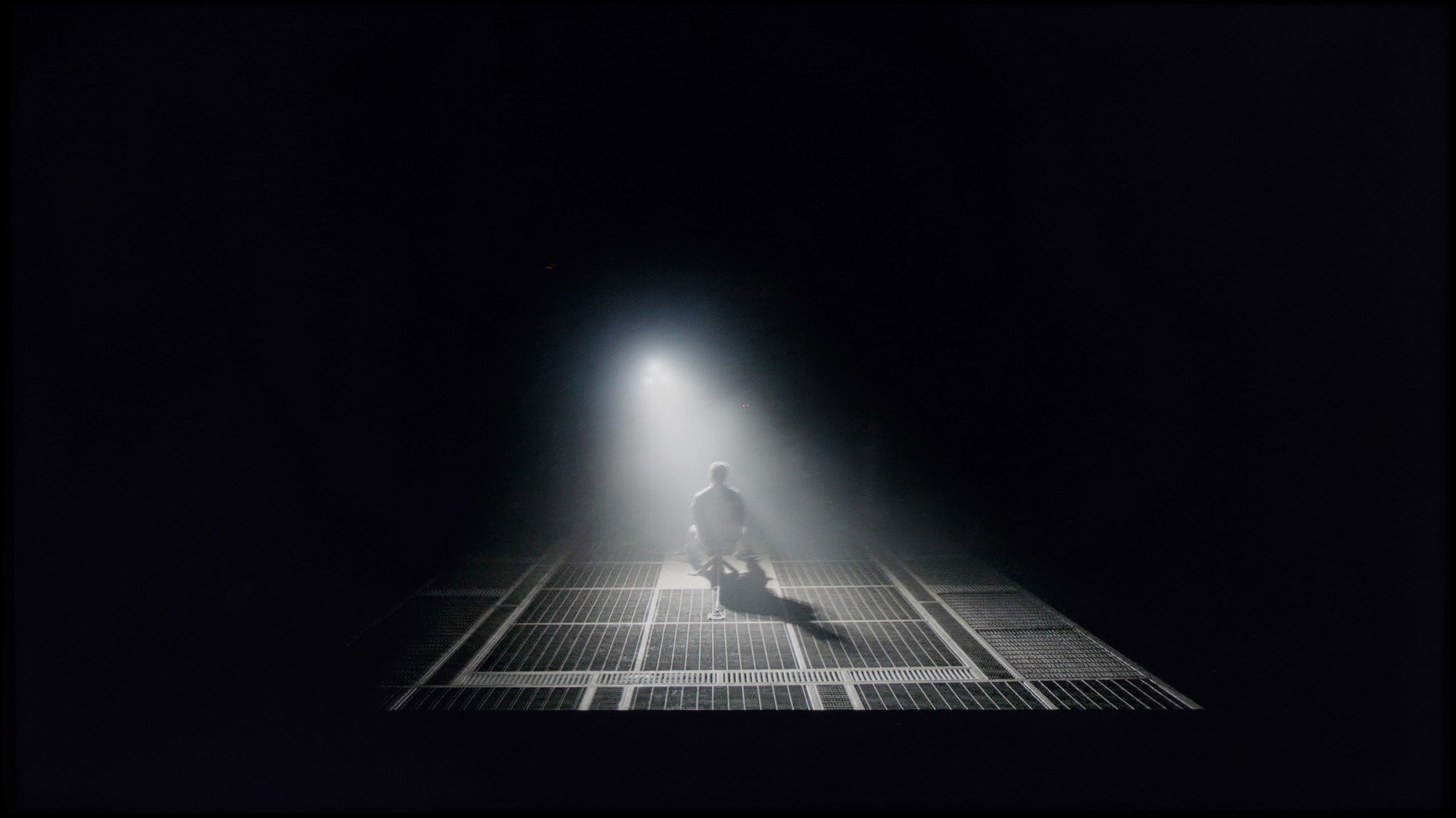
Sharp GR8 uses a VA panel, which can provide quite decent contrast. In tested movie scenes, for example in “Arrival,” the television showed that it can achieve really good results. A contrast ratio of 6600:1 is a figure that can be considered solid in this price segment. However, it should be noted that the television is not equipped with local dimming technology. This is quite obvious, considering the class of the equipment. Despite this, Sharp GR8 performs well with the separation of bright and dark elements, which definitely deserves recognition. However, it's important to remember that televisions without local dimming have their limitations. In very dark conditions, such as during a viewing in a completely dark room, black may take on shades of navy instead of appearing deep and pitch black. Overall, Sharp GR8 offers quite solid contrast that should satisfy most users.
Philips PUS8560 in the size version we tested is equipped with a VA panel. This means that black levels – for an LCD TV – can be considered decent. And that is indeed the case with this model. Both blacks and the overall impression of contrast in the movie scenes we tested are really quite good – the image doesn't bleed, and details are visible even in more challenging segments.
But the panel alone is not everything. Unfortunately, the PUS8500 does not come with local dimming (which is a given looking at the TV segment), so one has to reckon with the fact that in completely dark conditions, black can resemble shades of navy more than true black. On the other hand – and here's a plus for Philips – the Ambilight system does an excellent job. The backlighting really affects the perception of contrast. As a result, even if technically the black isn't perfect, the subjective experience of the picture becomes much more enjoyable. For many people, that's enough to make an evening viewing really spectacular.
HDR effect quality
4.8/10
4.1/10
Luminance measurements in HDR:

Result
305 nit

Result
332 nit

Result
369 nit

Result
365 nit

Result
367 nit

Result
273 nit

Result
300 nit

Result
324 nit

Result
343 nit

Result
334 nit
Scene from the movie “Pan” (about 2800 nits)


Scene from the movie “Billy Lynn” (about 1100 nits)


Static HDR10


Dynamic: Dolby Vision
Dynamic: HDR10+


HDR luminance chart:
Philips PUS8500
Luminancja HDR
Luminance of RGB colors
Sharp GR8
Luminancja HDR
Luminance of RGB colors
Sharp GR8 in its promotional materials boasts of "very high brightness" at a level of 500 nits. Unfortunately, our tests showed that reality is somewhat different – the average luminance we were able to achieve was around 360 nits. This is rather an average result, especially in the context of the manufacturer's claims. Such brightness does not allow for a full enjoyment of HDR effects. The image is a bit sharper than in standard SDR, but it's hard to talk about true vibrancy and depth of bright elements here. However, the coverage of the DCI-P3 colour palette at 95% deserves praise. This is the result of applying an additional PFS coating, known from QLED technology. As a result, colours are vibrant and have a pleasant, natural tone, which partially compensates for the shortcomings in brightness.
When it comes to HDR performance on the PUS8560, it's safe to say that it's rather average. The brightness of the panel is around 350 nits, so we consider this to be the absolute minimum for watching content in this format. However, it’s not a result that will impress viewers looking for the best possible picture.
On the plus side, it's worth noting that the PUS8500 series – including the PUS8560/12 tested here – is marketed as a QLED television. And indeed, we can expect a wider colour gamut here. This model is equipped with an additional filter (PFS), and the DCI-P3 coverage of around 90% should suffice for most users. This filter operates very similarly to quantum dots. As a result, colours are quite well-saturated. It's not an outstanding result, but it's entirely sufficient for watching movies and series from streaming platforms.
Factory color reproduction
5.4/10
6.2/10


Factory Mode
After calibration

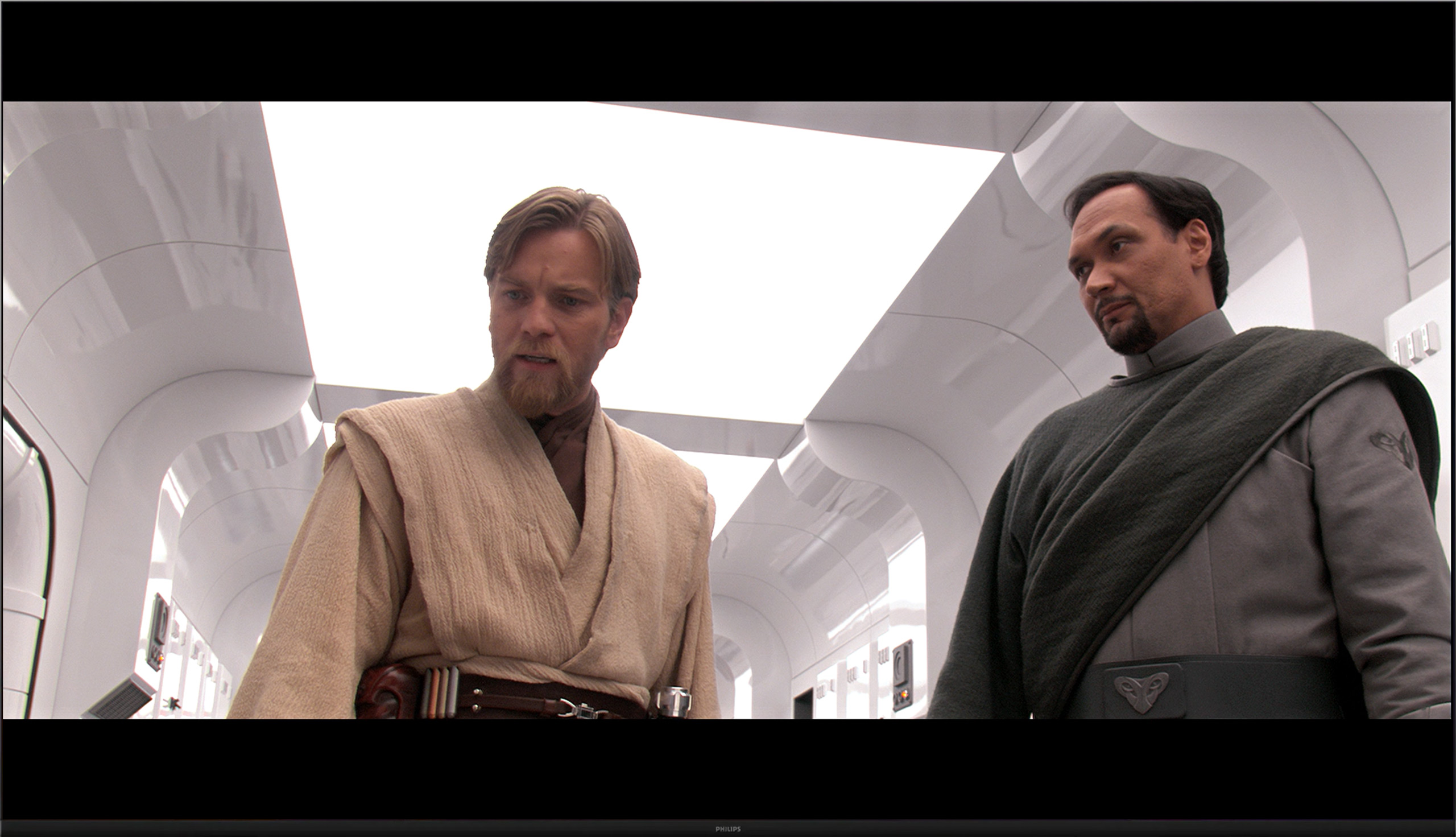
Factory Mode
After calibration
At the beginning, it's worth noting that colour reproduction tests are always conducted in the best factory picture mode. In the case of Sharp GR8, this is the “Film” mode. When it comes to white balance, which affects how we perceive colours on the screen, in SDR mode the strong dominance of blue immediately stands out. This results in an unnatural cooling of the image – blue elements take on a purple hue, and skin tones appear to have a pink tint, which we can see in the comparative photo from the film STAR WARS. During the Color Checker test, it was clearly visible how the colour samples deviated from the standard values, confirming significant errors in colour reproduction. The gamma was also not ideal – it caused excessive brightening of the entire image, causing the scene to lose depth and proper tonal transitions.
In the 4K HDR mode, the situation looks much better. The dominance of blue is much less noticeable, although there are minor issues with the blending of red and blue. This makes some shades look slightly unnatural. The EOTF curve, which is responsible for image brightness in 4K HDR content, showed another problem – the TV tends to excessively darken the image across the entire surface of the screen.
To summarise, the “Film” mode in Sharp GR8 would require some adjustments in order to fully utilise the potential of this television. Fortunately, we took care of this and proceeded with calibration.
We tested the television on the best available factory settings, that is, in Film/Filmmaker mode – this is the mode we recommend for everyday viewing. Unfortunately, it is not without its flaws. Both in HD and HDR content, the image had a distinct tendency to pinkness, caused by an excess of red and blue in the white balance. Another issue turned out to be excessive brightness of the image, as confirmed by both the gamma graph and the EOTF curve. This characteristic was responsible for the loss of detail and washed-out colours in more challenging HDR scenes we mentioned earlier. All of this led to quite significant colour reproduction errors – in extreme cases, the delta E value exceeded 7, while the threshold for visibility of errors for the human eye is about 3. This situation can be improved through calibration, and you can read about its effects below.
Color reproduction after calibration
8/10
8.4/10




Sharp GR8 is one of those televisions that really gains a second life after proper calibration. Both in HD and 4K content, the white balance performs very well, especially considering this model's price segment. The picture becomes significantly closer to what the director intended to show – colours appear natural, and skin tones gain the right depth and warmth. The brightness characteristics also leave a very positive impression. Both the gamma and the EOTF curve demonstrate really solid values. While slight imperfections can be noticed, they are subtle enough that it's difficult to see them during everyday viewing. In summary, calibration allows Sharp GR8 to show its best face, offering a picture that is not only pleasant to the eye but also faithfully conveys the creators' intentions.
The Dutch manufacturer offers quite a large dose of settings in its products, so as usual, we decided to tinker with them a bit. The effects are immediately noticeable – we managed to correct the white balance, which made the image cease to appear overly pinkish. The brightness characteristics were also partially equalised, of course within the limits that the television itself allows. The picture is no longer so excessively brightened, and the overall reception after calibration is definitely better than in the factory settings of the Filmmaker mode.
You could only nitpick about the characteristics of the EOTF curve, which still indicates that the image tends to brighten HDR content. Despite our efforts, the darkest parts of the scenes can still be too bright, and the brightest ones do not always reach their full contrast potential. However, it must be clearly stated that we are dealing with a typically budget-oriented design – one cannot expect reference-quality rendering of HDR content from it.
Calibration has definitely helped this model – it improved the balance, toned down the aggressive colour palette, and brought the image closer to what one can expect from a well-configured movie mode. However, there are certain limitations that cannot be overcome.
Smoothness of tonal transitions
8/10
6.3/10





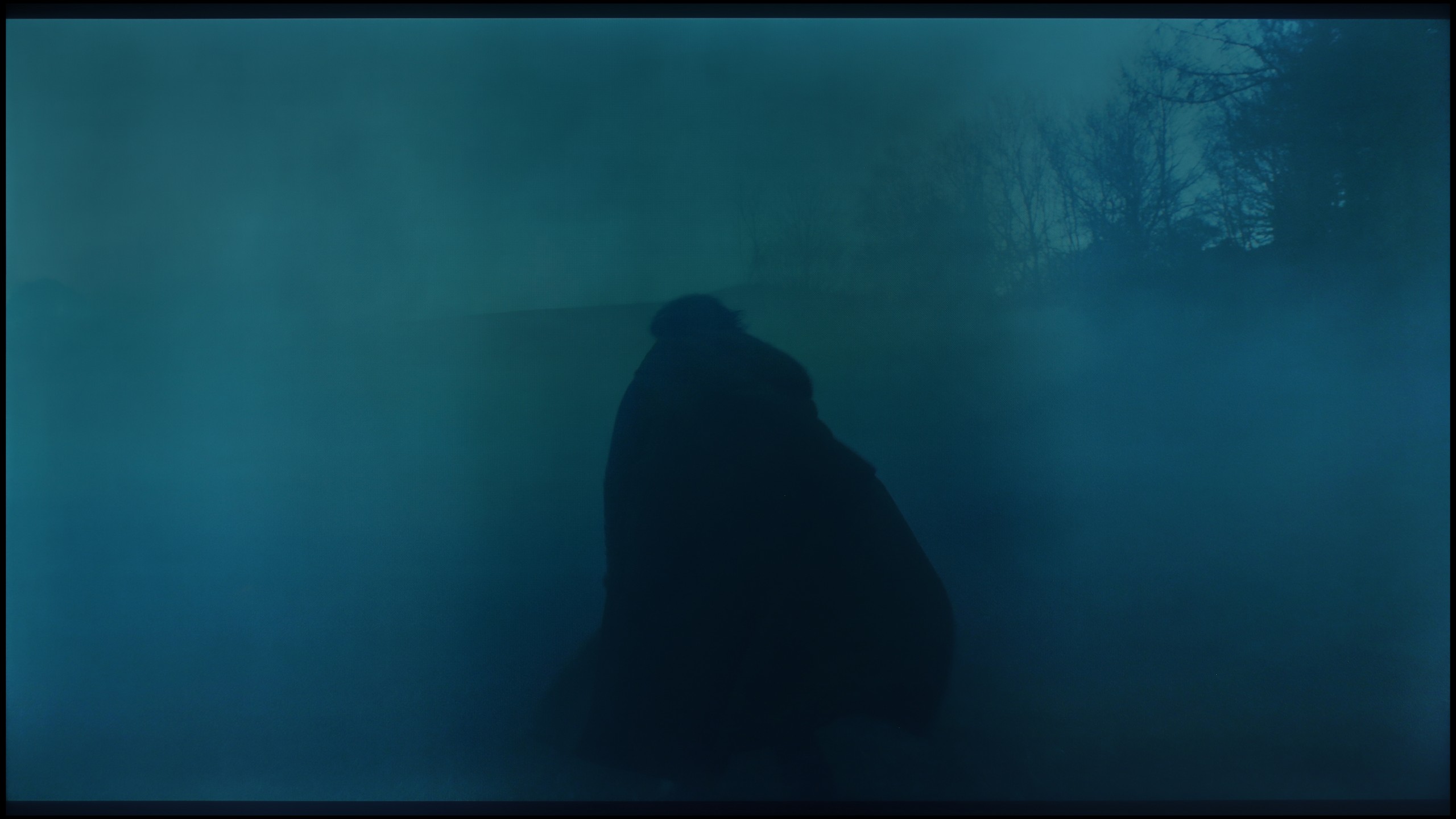






When it comes to the fluidity of tonal transitions in high-quality materials such as 4K, Sharp GR8 performs really well. Colour gradients are smooth, and transitions between shades are natural and free from visible artifacts. The television has no issues reproducing subtle differences in colours, even in demanding scenes. Only the most discerning users, who closely examine the image, may notice slight imperfections in the darkest shades. For most viewers, the quality of tonal transitions in the Sharp GR8 will be more than satisfactory and will not negatively affect the perception of the image.
The PUS8560 handles colour blending into smooth gradients very well. During testing, the image appeared coherent and natural, with serious issues regarding tonal transitions occurring only in very dark scenes – for example, in a shot with red water, where subtle cut-offs between colours could be observed. However, these are rather exceptions that don’t spoil the perception of most content. It’s worth mentioning another phenomenon that has a greater impact on image quality – this relates to the so-called dithering, which is a slight “tingling” visible on solid backgrounds. This effect can be particularly noticeable in high-quality materials and may slightly detract from the impression of image clarity. It is for this fault that we deducted some points in the rating.
Image scaling and smoothness of tonal transitions
5.5/10
6.1/10
Smooth transition function

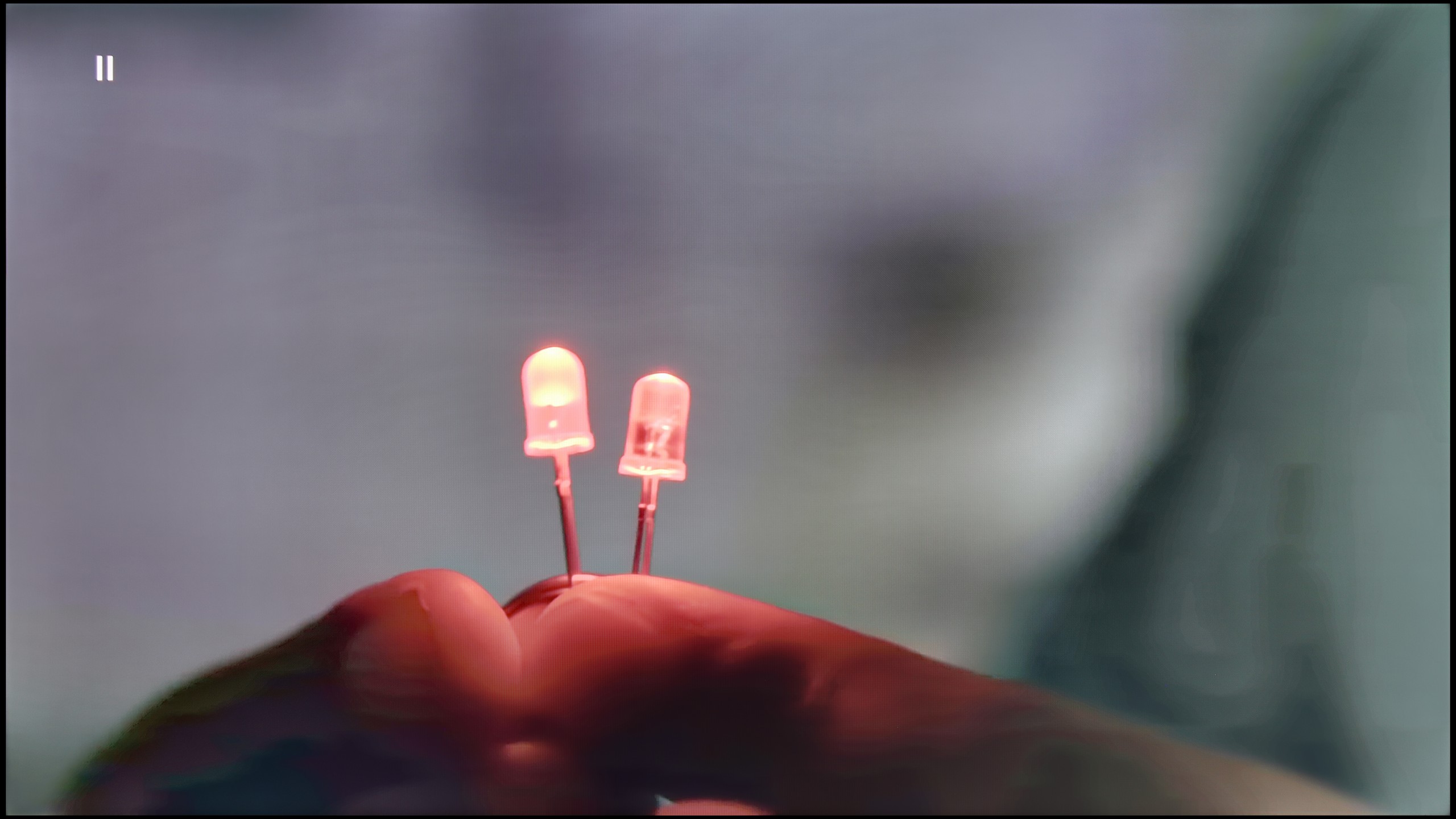
Image without overscan on the SD signal


Sharp GR8 is equipped with a feature called "10-bit colour reproduction," which theoretically should improve the smoothness of tonal transitions. In practice… well, the effect is surprising, but not in a very positive way. Even at the highest settings, it’s hard to notice any impact on the actual tonal transitions. Instead, the feature surprisingly smooths out things it shouldn’t - walls, shirts, or other flat surfaces look almost as if they have been ironed. In the test, we had to note that there is simply no actual impact on tonal transitions.
When it comes to image scaling, Sharp GR8 performs significantly better. The television can give the image a plastic, smooth characteristic, making even lower resolution content look quite good. Of course, with more demanding details, such as thin branches of trees in the background, you can see slight jaggedness, but it’s not something that would significantly affect the viewing comfort.
Philips PUS8560 offers a deinterlacing function, hidden under the name “distortion reduction”. And while it indeed serves its purpose, smoothing out problematic tonal transitions, it operates a bit too broadly. In practice, it affects not just colourful gradients but also softens faces, clothing textures, and furniture surfaces. This undermines the authenticity of the image – especially in films where natural texture is of great importance. However, if someone is looking for smoothing at any cost, it’s best to set this option to “Low”. For cinema image enthusiasts – we definitely do not recommend it.
On the plus side, the quality of scaling older materials is worth noting – the PUS8560 model handles them surprisingly well. The image retains a natural softness without artificially boosted sharpness. It’s also worth mentioning that the TV correctly displays very low-resolution content, avoiding issues with image cropping (so-called overscan).
Blur and motion smoothness
7.4/10
4/10


Blur (native resolution, maximum refresh rate):






This is where Sharp GR8 has the opportunity to stand out against the competition in its price segment. The television is equipped with a 144 Hz refresh rate panel, which is an impressive result, especially if we plan to use it for dynamic content such as action films, sports broadcasts, or video games. Additionally, the manufacturer has included a motion smoothing feature, commonly known as a 'smoother'. The user has three levels of adjustment available, allowing them to tailor the effect to their personal preferences – from subtle smoothing to a more aggressive intervention in the fluidity of the image. It's a nice addition, particularly for those who mainly watch films and care about smooth, cinematic sequences without annoying judders or stuttering.
The Philips PUS8560 is a television equipped with a 60 Hz refresh rate panel, which already limits its capabilities for displaying dynamic content right from the start. Watching sports or playing on a console is not one of the more enjoyable experiences. The situation is further worsened by the absence of any option to improve film fluidity. In the menu, you won’t find settings that would allow for the activation of motion smoothing or even a slight motion blur for films recorded at 24 frames per second. You can imagine the effect. The image can appear choppy, especially in shots with panoramic camera movements.
Console compatibility and gaming features
7.8/10
4.7/10
- ALLM
- VRR
- VRR range48 - 144Hz48 - 60Hz
- Dolby Vision Game Mode
- Correct implementation of HGIG
- 1080p@120Hz
- 1440p@120Hz
- 4K@120Hz
- Game bar

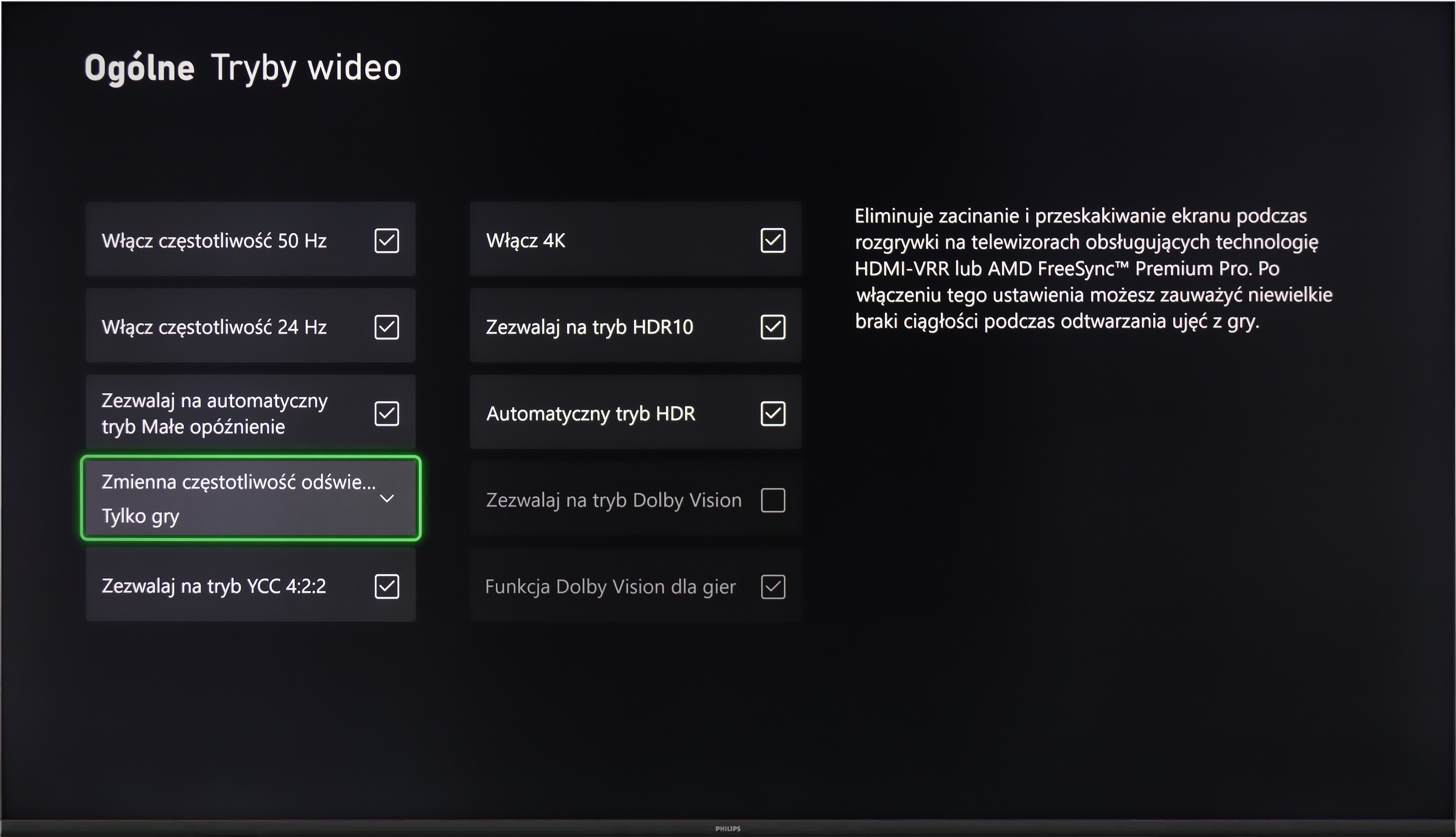

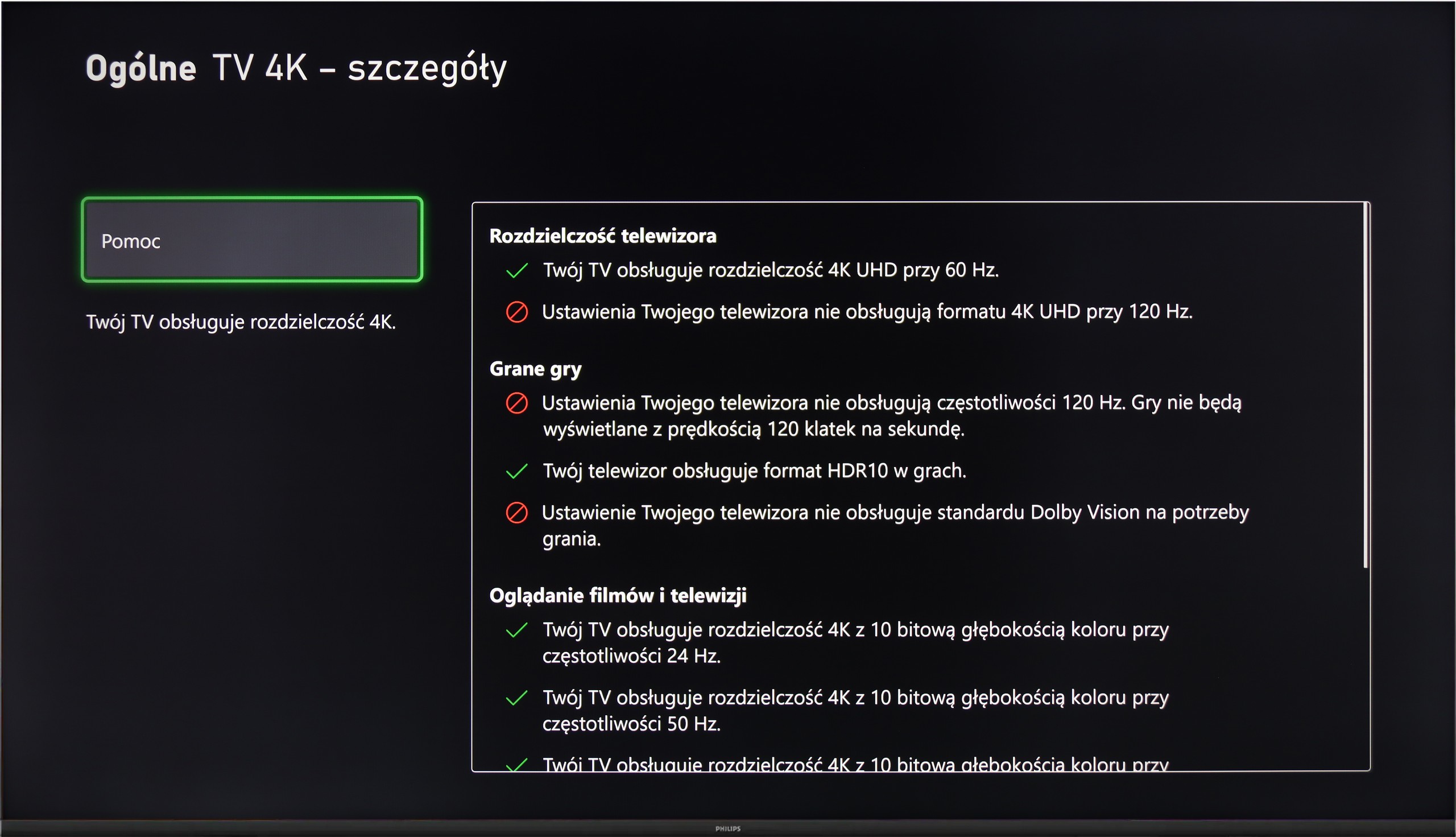

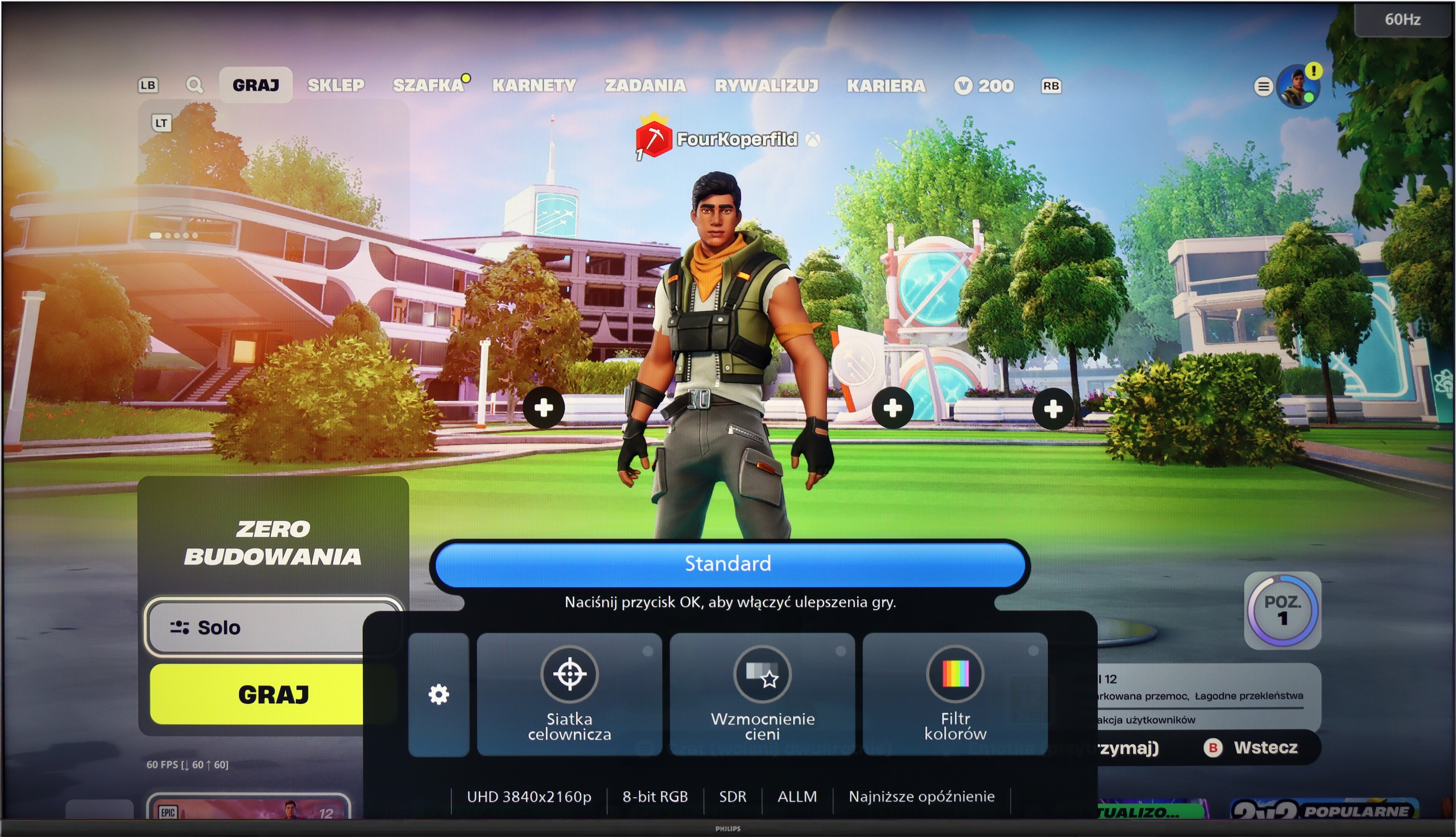

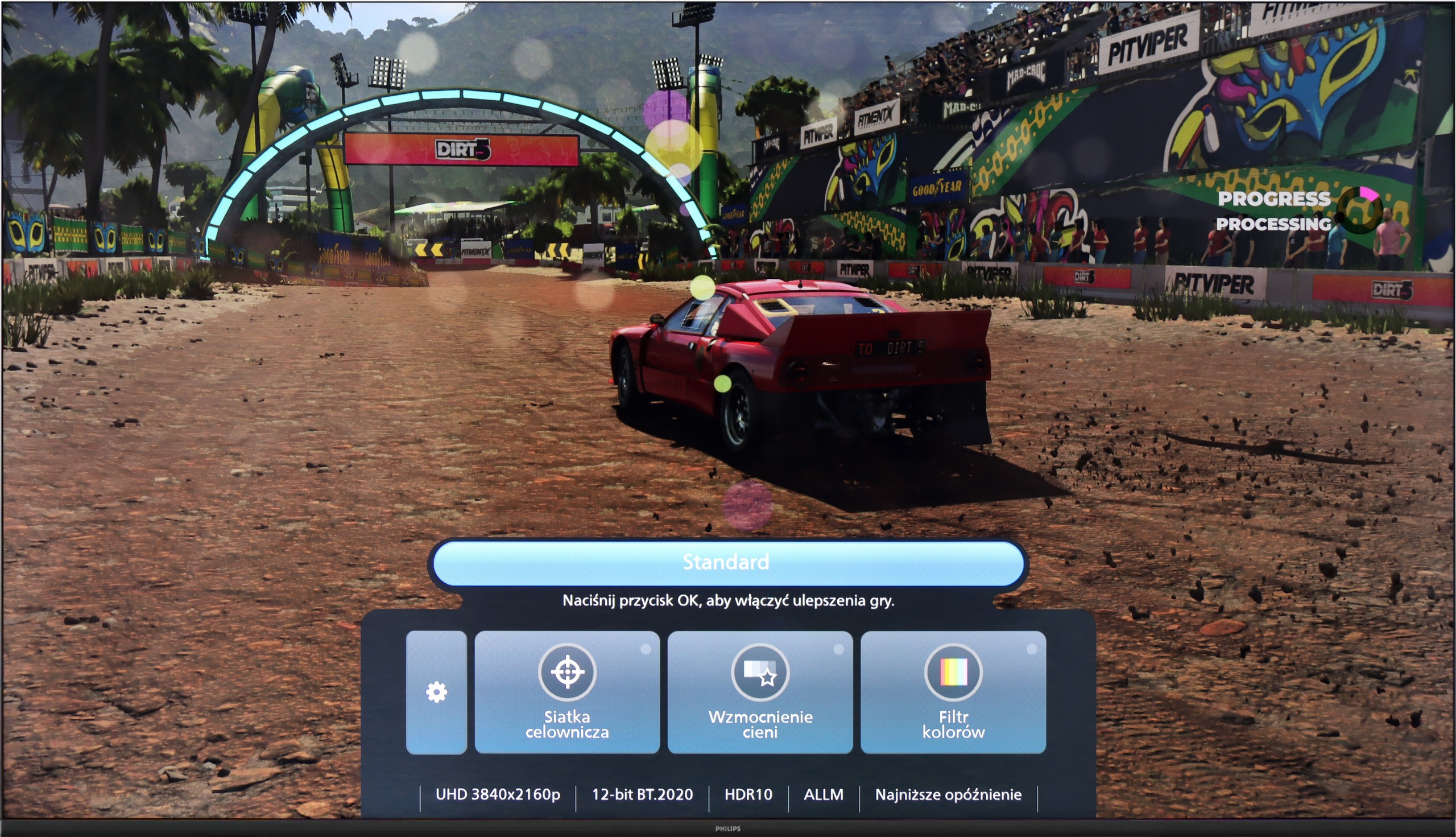
If the television has a 144 Hz panel and two full HDMI 2.1 ports, it’s clear it was designed with gamers in mind. The Sharp GR8 offers exactly that – high refresh rates and the right connections to get the most out of modern consoles and PCs. It also features ALLM, which automatically switches the TV to low latency mode, and VRR, ensuring the picture doesn’t stutter even in more demanding moments. In practice, everything works as it should, and it's difficult to find fault. However, it’s not without its shortcomings. There’s a lack of support for HGiG, which better adjusts HDR for games, as well as Game Bar, which makes it easier to quickly adjust settings without leaving the game. Despite these drawbacks, the Sharp GR8 is a really solid option for gamers.
Although the Philips PUS8560 is not designed with gamers in mind, the manufacturer has equipped it with a few features that may prove useful when connecting a console. Onboard, we find automatic switching to game mode (ALLM), as well as a simple connection status information bar – the so-called Game Bar. It doesn't make a particularly visual impression, but it serves its purpose. The presence of variable refresh rate (VRR), operating in the range of 48 to 60 Hz, may come as a surprise. This is not a wide range, but for less demanding games or titles with unstable frame rates, VRR can help reduce the tearing effect. However, this is the only element that can be considered beyond the minimum.
It must be clearly stated that the PUS8560 is not equipment for gamers looking for a responsive screen and full support for modern console features. It lacks HDMI 2.1 ports, the refresh rate is limited to 60 Hz, and the panel's response time is not among the fastest. This model may at best suit people who play occasionally and want to enjoy the Ambilight system.
Input lag
9.7/10
10/10
SDR
HDR
Dolby Vision
Sharp GR8 performs really well in terms of delays. With a refresh rate of 120 Hz, the input lag is only 9 ms, and at 60 Hz – about 18 ms. These values are practically imperceptible even for the most demanding gamers, where every millisecond counts. Importantly, the Dolby Vision mode also works responsively, which is not a standard in TVs within this price range. This is definitely a big plus for those who want to enjoy not only smoothness but also better HDR effects while gaming.
The input lag on the PUS8560 is very good. When we previously mentioned that this screen is rather for the "casual gamer", there's nothing to be ashamed of in this regard – even compared to screens aimed at gamers. Results around 12 ms are truly remarkable, allowing for an enjoyable responsive gameplay experience. It doesn't matter whether we're playing in Full HD or 4K – the lag remains equally low, so if you're after a fast reaction time, the PUS8560 definitely won't disappoint in this area.
Compatibility with PC
4/10
5.6/10

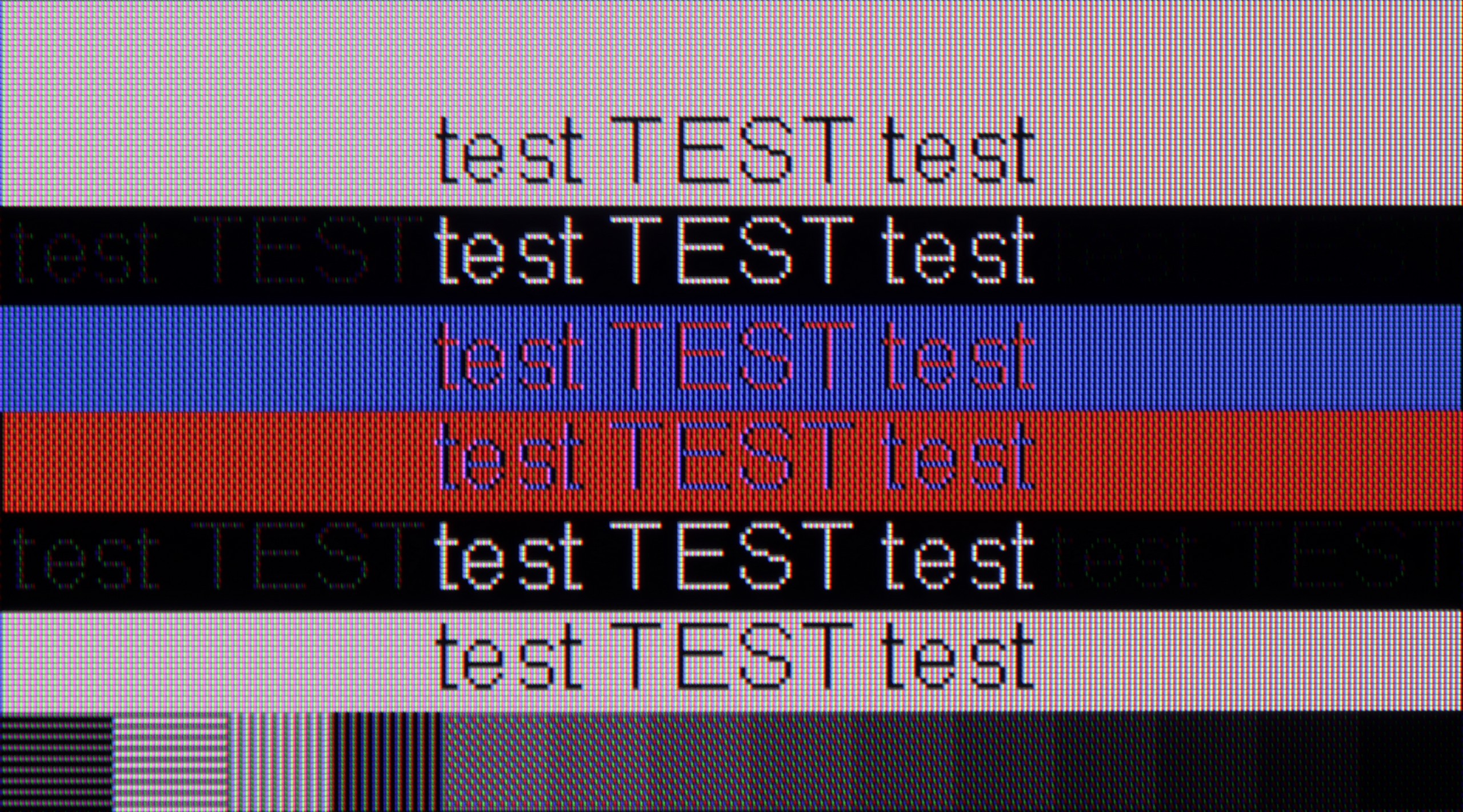
Sharp GR8 performs quite well as a screen for PC gaming. With a refresh rate of 144 Hz, low input lag, and support for G-Sync and FreeSync technologies, it's a set that guarantees smooth and responsive gameplay. Games look dynamic, and the image remains stable even in the most demanding moments. However, a problem arises when it's time to work with text. The television does not support chroma 4:4:4, which means fonts are blurred and difficult to read. Longer work with documents or browsing websites can become simply tiring on the eyes.
Sharp GR8 is a great choice for PC gamers, but rather poor for office work. If we plan to use this television mainly for gaming, we should be satisfied. However, if we think of it as a monitor for everyday work, it's better to look for another solution.
If we're talking about working with a PC on the PUS8560, it looks… quite strange. Chroma 4:4:4 is present in “Monitor” mode, but there’s a problem with grey fonts – not all subpixels light up, which makes the text appear jagged. Meanwhile, in “Game” mode, chroma 4:4:4 disappears, but the grey fonts look correct. In practice, we are therefore forced to juggle settings if we want to have perfectly readable text all the time. And what about gaming on a computer? Here our opinion remains unchanged compared to consoles – it’s possible, but without fireworks. There’s no variable refresh rate for G-SYNC graphics cards, and the refresh rate itself remains relatively low. On the plus side, we can once again highlight the very low input lag, which saves the situation in fast-paced games.
Viewing angles
3.2/10
3.3/10
When it comes to viewing angles, Sharp GR8 doesn't surprise – and it's hard to blame it, considering the use of a VA panel. When watching from a more significant angle, the image loses quality, colours become washed out, and contrast noticeably drops. Additional coatings that widen viewing angles could improve this aspect, but that's a solution we typically find in more expensive LCD TV models. If we plan to watch television mainly straight on, there won't be much of a problem. However, in the case of a larger number of viewers sitting at different angles, it's worth being aware of this limitation.
The viewing angles on the PUS8560 are exactly what you'd expect from a VA panel - it's not the best. The image loses quality even with a slight shift off-axis – colours become washed out, and blacks start to resemble a dark navy. This is, of course, the price for the better contrast that VA offers head-on. In the case of our 55-inch model, it can still be acceptable, especially if the TV is positioned perfectly in front of the couch. But with larger screens or a less central setup in the living room – it could be a problem for comfortable viewing.
TV efficiency during daytime
4.5/10
4.9/10

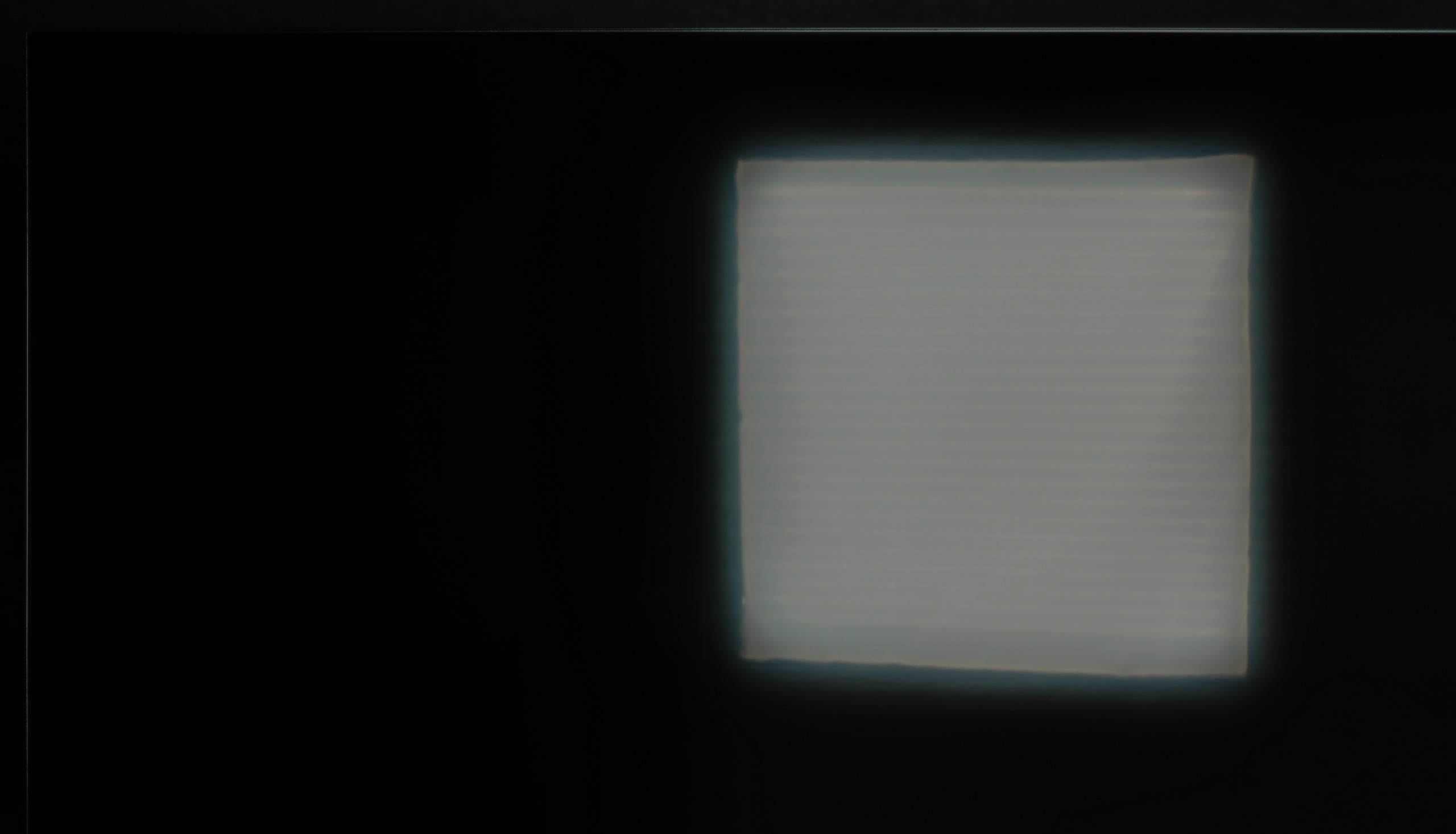

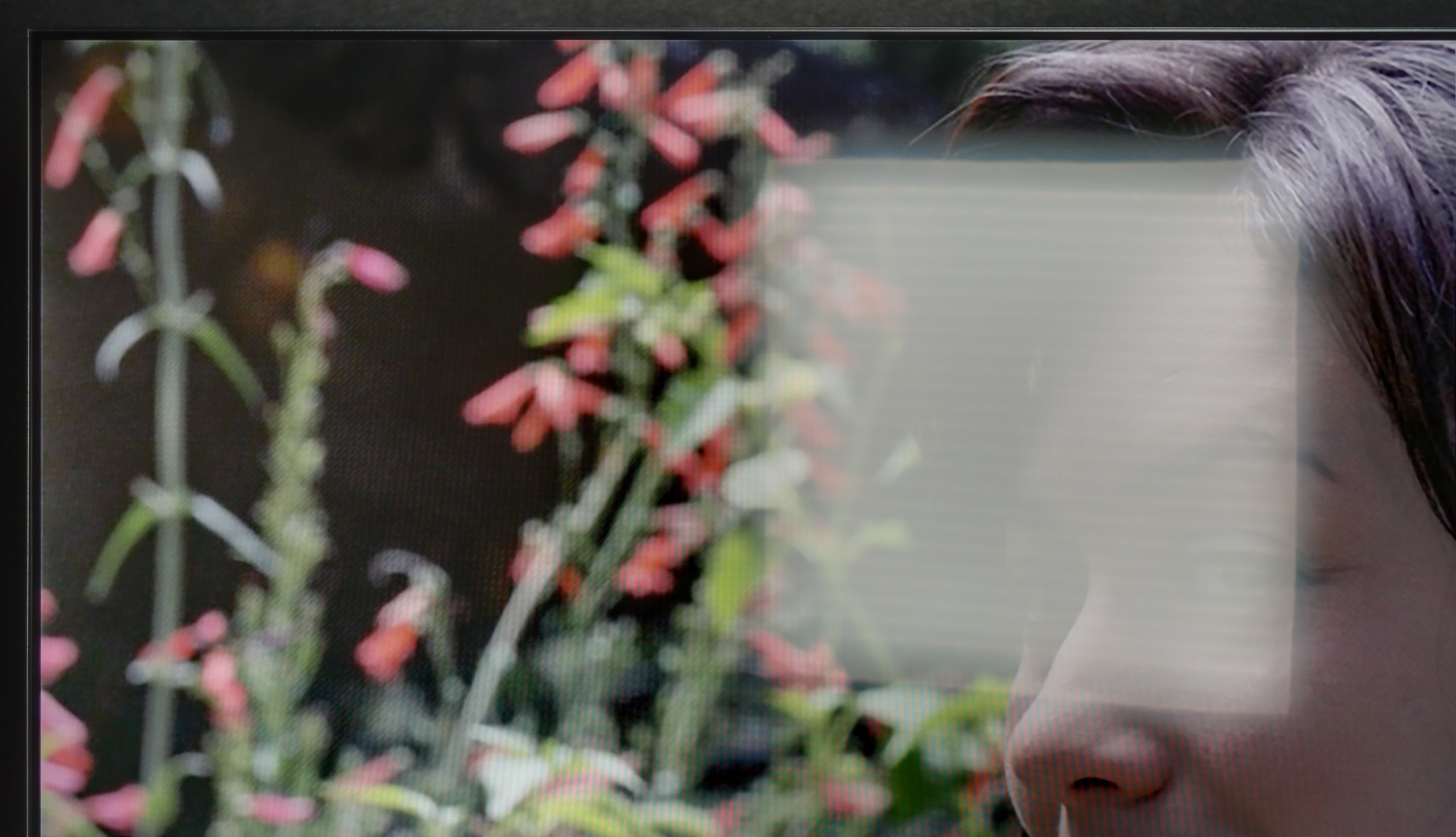
Matrix brightness
Average luminance SDR
Philips PUS8500 : 331 cd/m2
Sharp GR8: 329 cd/m2
Sharp GR8 has a satin finish display that performs average with reflections. Bright surrounding elements, such as windows or lamps, quite clearly reflect on the screen and can be distracting while viewing. The brightness level of 330 cd/m² in SDR content is also unimpressive. As a result, the television is best suited for rooms where not too much natural light comes in. So, it can be said that the GR8 holds up during the day, but it is certainly not equipment made for brightly lit living rooms. If we mainly watch in the evenings or in controlled lighting, it won’t be a major issue.
The PUS8560 performs reasonably well during the day... moderately. The satin finish of the panel does a pretty good job of reducing reflections, which means that light from windows or lamps doesn't interfere too much. The black levels also look decent for a VA panel – even in daylight, there aren't significant contrast losses. But the magic fades when it gets really bright. The panel's brightness is around 300 nits, which is definitely too little to speak of full comfort in a heavily sunlit room. In such conditions, the PUS8560 simply needs to be complemented with blinds – otherwise, the picture starts to look quite washed out.
Details about the matrix
Subpixel Structure:

Panel uniformity:


Sharp GR8
Philips PUS8500
TV features
6.5/10
4.9/10
- HDMI inputs2 x HDMI 2.0, 2 x HDMI 2.1 48Gbps3 x HDMI 2.0, 0 x HDMI 2.1
- Other inputsRCA (Chinch)
- OutputsToslink (Optical audio), eARC (HDMI), ARC (HDMI), Mini-Jack (Headphones)Toslink (Optical audio), eARC (HDMI), ARC (HDMI), Mini-Jack (Headphones)
- Network InterfacesWi-Fi 2.4GHz, Wi-Fi 5GHz, Ethernet (LAN) 100MbpsWi-Fi 2.4GHz, Wi-Fi 5GHz, Ethernet (LAN) 100Mbps
- TV receptionDVB-T, DVB-T2, DVB-S, DVB-S2, DVB-CDVB-T, DVB-T2, DVB-S, DVB-S2, DVB-C
Classic features:
- Recording to USB (terrestrial TV)
- Recording programming
- Picture in Picture (PiP)
- RF remote control (no need to aim at the screen)
- Backlit remote control
- Teletext
- Audio only mode
- Possibility to connect Bluetooth headphones to the TV
- Possibility to simultaneously use Bluetooth headphones and the TV speaker
Smart features:
- AirPlay
- Screen mirroring (Windows Miracast)
- Wyszukiwanie głosowe
- Voice search in native language
- Ability to connect a keyboard and mouse


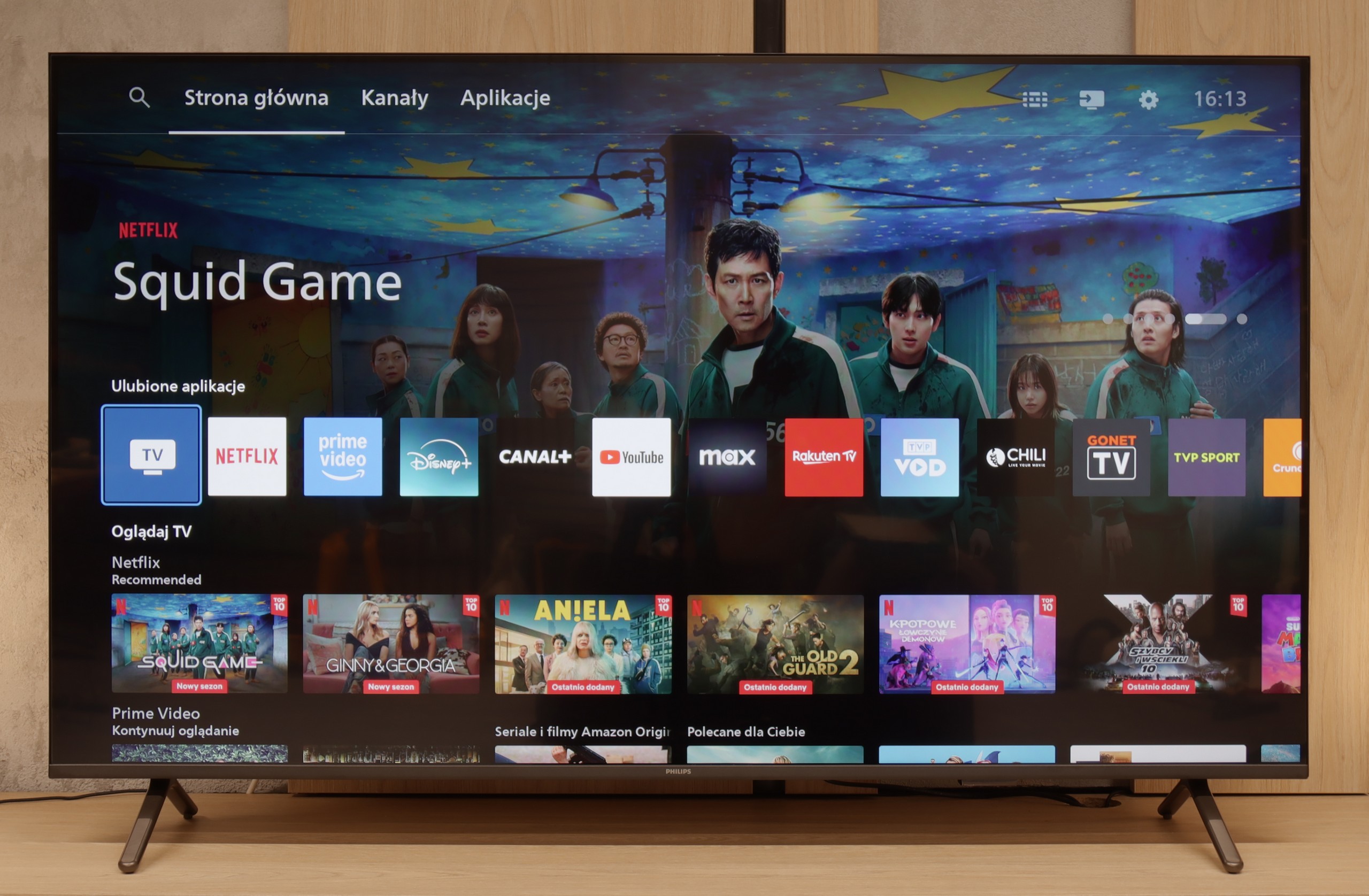
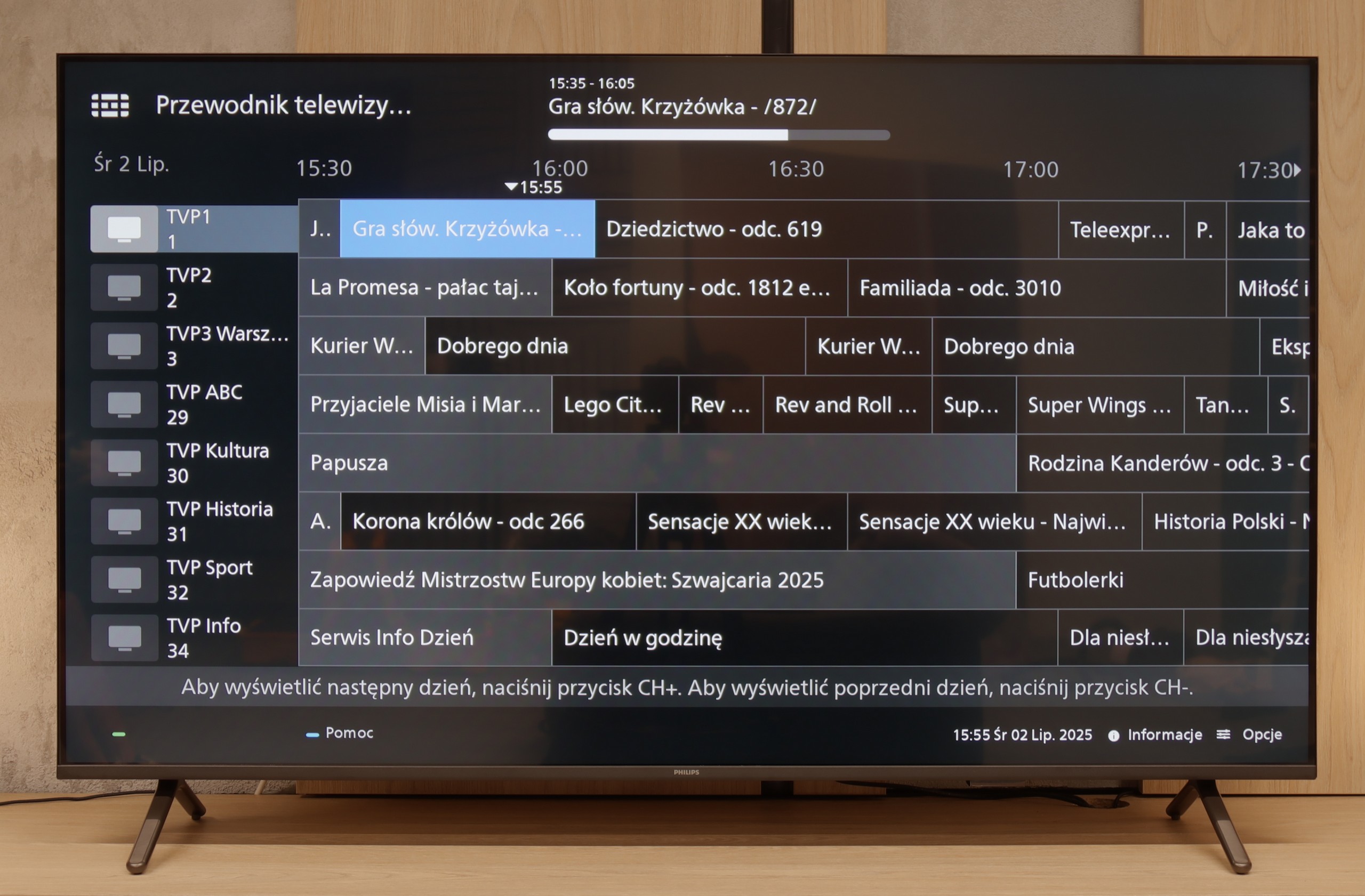
Google TV is definitely the biggest advantage of Sharpa GR8. This system is a true multimedia powerhouse – it includes practically all popular streaming apps, such as Netflix, HBO Max, and Disney+. Voice search works in Polish and, importantly, is really responsive. We can tell the TV what we want to watch, and it quickly finds the right content. Plus, the interface is clear and intuitive, so even people who aren't keen on technological innovations can manage without any problem. In short, Google TV gets the job done.
Unfortunately, when it comes to more classic functions, the GR8 is rather average. There are no options for USB recording or PiP (picture in picture) functionality. Moreover, although the TV supports Bluetooth connectivity, iPhone users may feel disappointed as there is no support for AirPlay.
The remote included is simple but well thought out. It has a solar panel on the front, allowing it to be charged by light, and the additional charging port means we don’t have to worry about changing batteries. Also, it’s a plus that the remote doesn’t require aiming at the screen – it works regardless of which way it’s pointed.
Classic TV Features:
If you’re looking for a TV that, in the basic sense, “works” – the PUS8560 will fill that role. In terms of classic features, we have a rather minimalist set. On the plus side, there’s an electronic program guide (EPG), teletext, a backlit remote with a classic numeric keypad, and a headphone jack input. It sounds a bit like a dream set for seniors – and there’s some truth to that. However, it must be said clearly: this is a TV with very limited capabilities. We won’t find USB recording from DVB tuners here, and there’s no Picture-in-Picture mode or other conveniences known from more expensive models.
Smart TV:
How does SmartTV fare on the PUS8560? Well, it gets a bit trickier here. The PUS8560 runs on the Titan OS, which in this particular implementation posed significant issues. Some functions, though present “on paper,” simply didn’t work. For example: Wireless screen mirroring features like Chromecast or Miracast – we tried to activate them with several different phones and laptops… without success. Perhaps this will be fixed in the future, but at the time of testing – it didn’t work. Also, the speed of the system left much to be desired – switching applications or home screens was simply slow. A substantial portion of the functions in the menu seem to be heavily hidden in the depths of a poorly organised system. To make matters worse, the library of available applications is quite limited. Although the situation with apps is better than last year, it’s still far from ideal. A modern remote tries to save the situation – slim, elegant, backlit and really well-made. Unfortunately, it operates on classic infrared, so you have to aim it at the screen. The only exception is voice control, which works via Bluetooth… it’s just a pity it doesn’t support Polish.
Playing files from USB
9.1/10
8/10
Supported photo formats:
Maximum photo resolution:

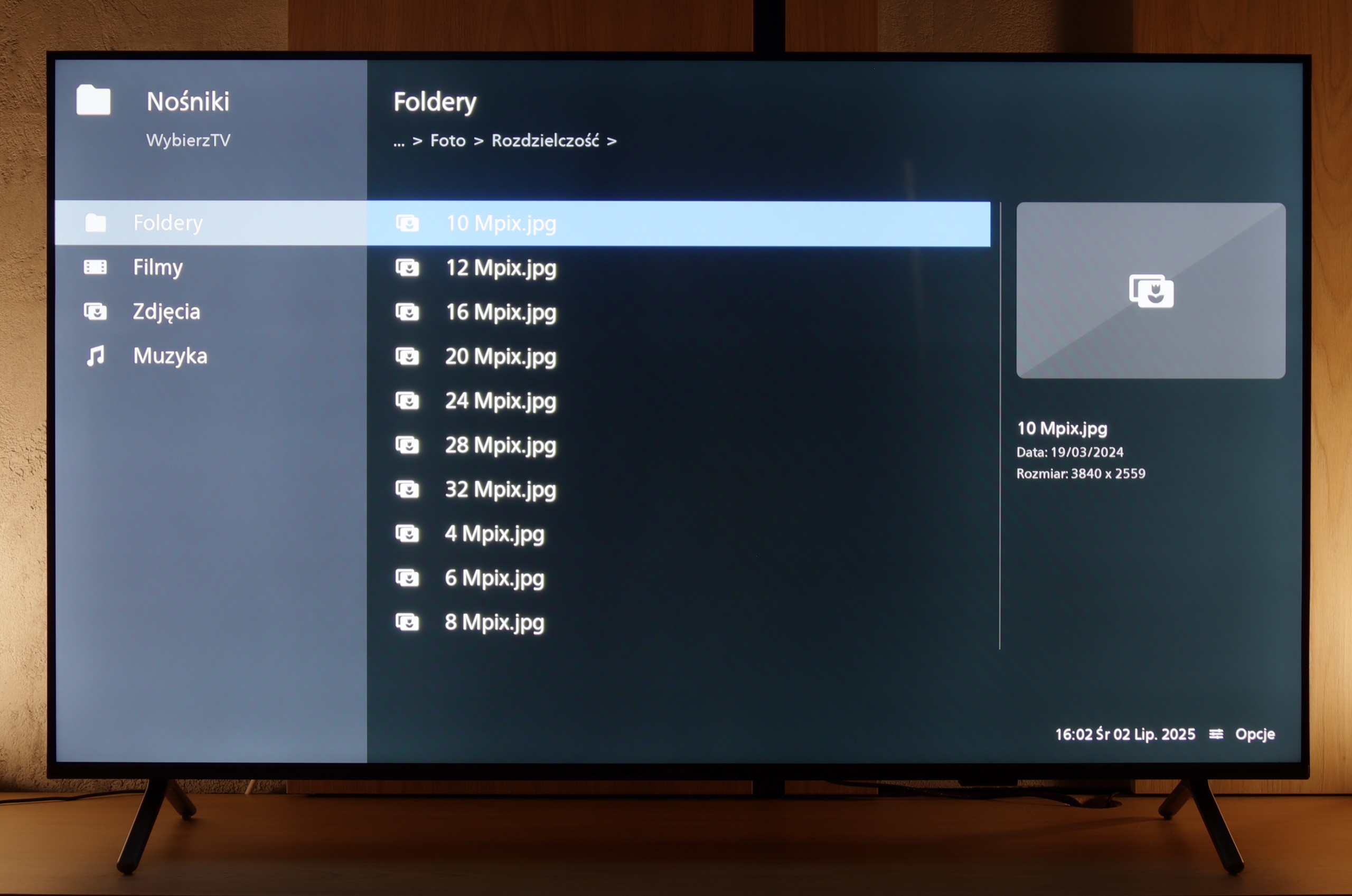
Sharp GR8 handles multimedia playback from USB really well. It supports practically all popular audio and video formats, so we don’t have to worry about any files not playing.
However, the built-in player has its limitations – for instance, we won’t find the option to change the font colour in subtitles here. Fortunately, the Google TV system allows us to bypass this issue. All you need to do is download an alternative media playback app from the Google Play Store that offers more advanced configuration options.
PUS8560 handles most popular video and audio formats from USB memory without much hassle, so there's no need to elaborate on individual compatibilities. In everyday use, it should just work – and it does. The only thing worth noting is the handling of images. Although the television easily recognises popular extensions, with very high resolution graphic files, there are times when some images simply won't display. It might not be a major issue, but it's good to keep it in mind, especially if we want to view photographs straight from the camera. Besides that, PUS8560 shouldn't have any major problems playing files from USB.
Apps
9.6/10
4.6/10














































Sound
7/10
6.2/10
- Subjective sound quality:7/106.2/10
- Dolby Digital Plus 7.1:
- Dolby True HD 7.1:
- Dolby Atmos in Dolby Digital Plus (JOC):
- Dolby Atmos in Dolby True HD:
- DTS:X in DTS-HD MA:
- DTS-HD Master Audio:
Sharp GR8 pleasantly surprises with its sound quality. Although it comes with a standard set of speakers, you can hear the influence of collaboration with Harman/Kardon. The sound is clear, dialogue is well-highlighted, and the overall sound profile is pleasant to the ear. It's not at the level of flagship models with advanced audio systems, but for this price segment – it's really good.
Unfortunately, Sharp has chosen to remove the built-in soundbar that we saw in the previously reviewed model Sharp FQ8. It's a shame because this solution significantly enhanced the sound quality and gave the TV an edge over the competition.
The television sounds quite pleasant, and it can confidently be said that the audio level will be fully adequate for most users – for both watching daily programs and enjoying an evening binge of a series. Moreover, it's a nice surprise that even in such an affordable Philips series, they decided to acquire licenses for full audio formats such as Dolby Atmos and DTS. This is great news for home theatre and soundbar owners, as it means complete compatibility and no need to "fiddle around" with connecting external devices.


